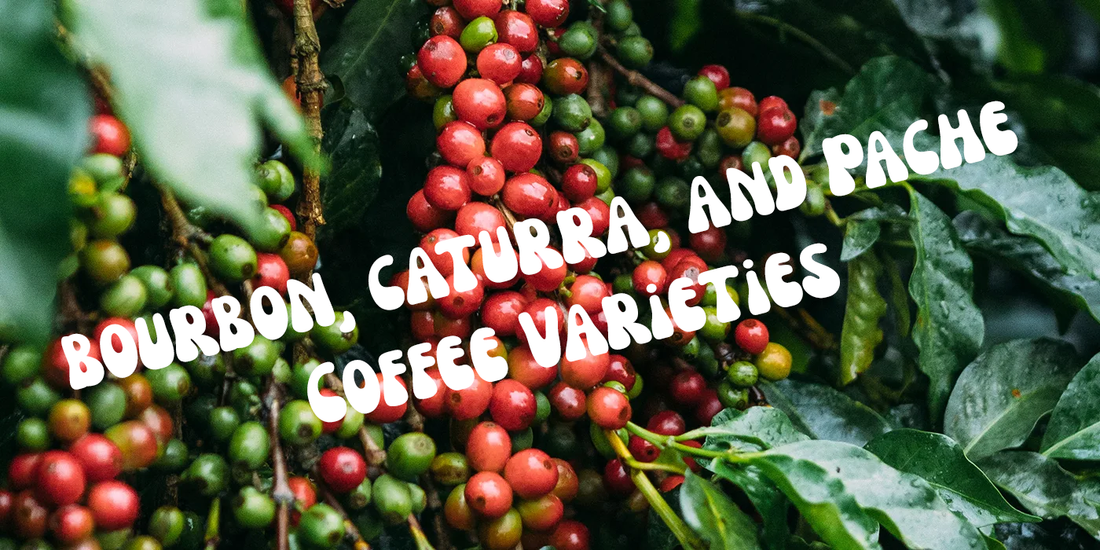We dropped a new espresso this month at Achilles Coffee. We generally change up our offering several times a year and prefer Central American coffees for espresso. Achilles Coffee has gravitated towards Central American offerings mostly due to our proximity to the farms there and the fact we have direct trade relationships with several Central American farmers. We also prefer single origins over blends. I’m sure the blend vs single origin is controversial between some roasters but for me it is just a personal preference. This month we started offering a Guatemalan Hue Hue (Huehuetenango). While the coffee is a single origin it is comprised of Bourbon, Caturra, and Pache coffee varieties.
I thought this would be a great opportunity to take a deaper dive into these varieties and write a blog post detailing the characteristics of different coffee varieties.
The Bourbon variety of coffee is one of the most famous and historically significant Arabica coffee varieties. Originating from the island of Bourbon (now Réunion Island) in the Indian Ocean, this coffee variety is known for its balanced flavor profile and high-quality beans.
Key Characteristics of Bourbon Coffee
- Bourbon coffee beans are known for their complex and nuanced flavors. They often have a balanced acidity, medium body, and a natural sweetness, with notes ranging from chocolate and caramel to fruity undertones, like red berries or citrus.
- Bourbon coffee plants tend to have a relatively low yield compared to some other varieties, such as the Caturra or Catuaí. However, the quality of the beans is generally considered higher, which makes it a preferred choice for specialty coffee.
- Bourbon coffee is commonly grown in Latin America, particularly in countries like Brazil, Colombia, and El Salvador. It is also found in parts of Africa, like Rwanda and Burundi, where it thrives in the high-altitude growing conditions.
- The Bourbon coffee plant has distinctively broad leaves and relatively small, round cherries. It is susceptible to diseases like coffee leaf rust, but many farmers still grow it due to its superior cup quality.
- Bourbon is one of the two main cultivars of Arabica coffee, the other being Typica. Many modern coffee varieties are hybrids or descendants of Bourbon, making it a foundational variety in the coffee world.
Caturra is a natural mutation of the Bourbon variety of Arabica coffee. It was discovered in Brazil in the early 20th century and is now grown in many coffee-producing countries, particularly in Latin America. Here’s a closer look at what makes the Caturra variety unique.
Key Characteristics of Caturra Coffee
- Caturra coffee is known for its bright acidity and balanced flavor profile. It often has a sweet, fruity, or floral aroma with notes that can range from citrus and tropical fruits to chocolate and caramel. The flavor is generally clean and vibrant, with a medium body, making it popular among specialty coffee roasters.
- Caturra plants are a dwarf mutation of Bourbon, which makes them shorter and more compact. This characteristic is beneficial for farmers because it allows for denser planting and easier harvesting, particularly on steep slopes. While Caturra can have a relatively good yield compared to other varieties, it requires careful management and ideal growing conditions to produce high-quality beans.
- Caturra is widely grown in countries like Brazil, Colombia, Nicaragua, Costa Rica, and Guatemala. It thrives at medium to high altitudes (around 1,000 to 1,800 meters above sea level) and benefits from cooler temperatures and rich volcanic soils.
- Unlike some newer hybrids, Caturra does not have inherent resistance to coffee leaf rust (a common fungal disease) or other major coffee diseases. This vulnerability means that farmers need to be diligent with pest management and crop care. However, its adaptability and relatively high yield make it a favored choice in many regions despite these challenges.
- Caturra plants have short, bushy growth with a compact structure. They produce smaller cherries and beans compared to other varieties like Typica or Bourbon, but these beans can offer excellent quality in the cup.
- Caturra is an important variety for specialty coffee due to its balance of quality and productivity. It is often chosen by farmers who want to achieve good yields while also producing high-quality beans that can fetch premium prices in the specialty market.
Caturra is valued for its excellent cup quality, balanced flavor profile, and productive growth characteristics. While it requires careful cultivation and management, it remains a popular variety among coffee farmers and specialty roasters world wide.
The Typica variety of coffee is one of the oldest and most historically significant cultivars of Arabica coffee. It is one of the two main foundational varieties of Arabica coffee, alongside Bourbon, from which many modern coffee varieties have descended. Typica is known for its high-quality cup profile and has played a crucial role in the spread and evolution of coffee cultivation worldwide.
Key Characteristics of Typica Coffee
- Typica coffee is renowned for its clean, sweet, and complex flavor profile. It often exhibits a bright acidity, a smooth and balanced body, and notes that range from sweet and fruity to floral and spicy, with a hint of nuttiness or chocolate. This variety is highly valued by specialty coffee roasters for its distinctive and refined flavors.
- The Typica plant is known for its tall growth and low productivity compared to other varieties. It has a conical shape with elongated leaves and branches that are widely spaced, which gives it an open structure. While it is not as productive as some other coffee varieties, the quality of its beans is typically higher, which makes it a favored choice for producing high-end specialty coffee.
- Typica is grown in many coffee-producing regions around the world, particularly in Latin America (like Colombia, Guatemala, and Peru), Africa (like Ethiopia and Kenya), and Asia (like Indonesia and India). It thrives in high-altitude environments where cooler temperatures and rich soils help develop its distinctive flavor profile
- Typica plants are tall and have a characteristic pyramidal shape with horizontal branches. They produce relatively small and elongated coffee cherries and beans. The plant is known for its long maturation period, which can contribute to the development of its complex flavors.
- One of the drawbacks of the Typica variety is its susceptibility to diseases and pests, particularly coffee leaf rust and coffee berry disease. Because of this, many farmers may choose to plant Typica in areas less prone to disease or at higher altitudes where cooler temperatures help reduce the risk of infection.
- Typica is considered a genetic parent to many of the world's coffee varieties. Most of the coffee varieties cultivated today have descended from either Typica or Bourbon, making Typica a foundational variety in the coffee world. It has contributed to the genetic diversity of Arabica coffee and has been used in breeding programs to develop new varieties that offer improved disease resistance, yield, and quality.
Typica is one of the most important and respected varieties in the coffee world due to its superior cup quality and historical significance. It is often grown in regions where quality is prioritized over quantity, and it is sought after by specialty coffee buyers and roasters who value its unique flavor characteristics.
While the Typica variety may not be the most productive or disease-resistant, it is cherished for its exceptional quality and flavor. Its rich history and contribution to the development of modern coffee varieties make it a cornerstone of coffee cultivation worldwide.
The Pache variety of coffee is a mutation of the Typica variety, which, as previously mentioned, is one of the original and most historically significant Arabica coffee cultivars. The Pache variety originated in Guatemala in the 1940s and has since become popular in Central America for its desirable growth characteristics and cup quality.
Key Characteristics of Pache Coffee:
- Pache coffee beans often have a mild and pleasant flavor, with a balanced acidity and body. Depending on the growing conditions, they can exhibit a range of flavors from sweet and nutty to fruity or floral. However, compared to other varieties, Pache is often characterized by a more subtle and delicate flavor profile.
- Pache is known for its relatively high yield compared to other varieties like Typica or Bourbon. It grows well at medium altitudes, which makes it suitable for a range of coffee-growing regions. The variety also has relatively large cherries and seeds, which can be an advantage for certain types of processing.
- One of the primary reasons for the popularity of the Pache variety is its partial resistance to certain diseases, such as coffee leaf rust. While not fully resistant, it is less susceptible than some other traditional varieties, which makes it an appealing choice for farmers looking to balance quality with disease management.
- Pache is primarily grown in Guatemala but is also found in other Central American countries like El Salvador and Honduras. It tends to thrive in areas with good soil quality and moderate altitudes, typically between 1,200 and 1,500 meters above sea level.
- The Pache coffee plant is relatively short and compact, which makes it easier to manage and harvest. This growth habit also makes it suitable for more densely planted farms, which can help increase productivity.
The Pache variety is valued for its combination of good yield, disease resistance, and desirable cup qualities. It is often grown on smaller farms where farmers seek a balance between productivity and quality. While it may not have the same high reputation as Bourbon or Geisha in the specialty coffee world, it is nonetheless respected for its adaptability and consistent performance.
Click here to visit our Guatemala espresso page and try Bourbon, Caturra, and Pache coffee varieties for yourself.







